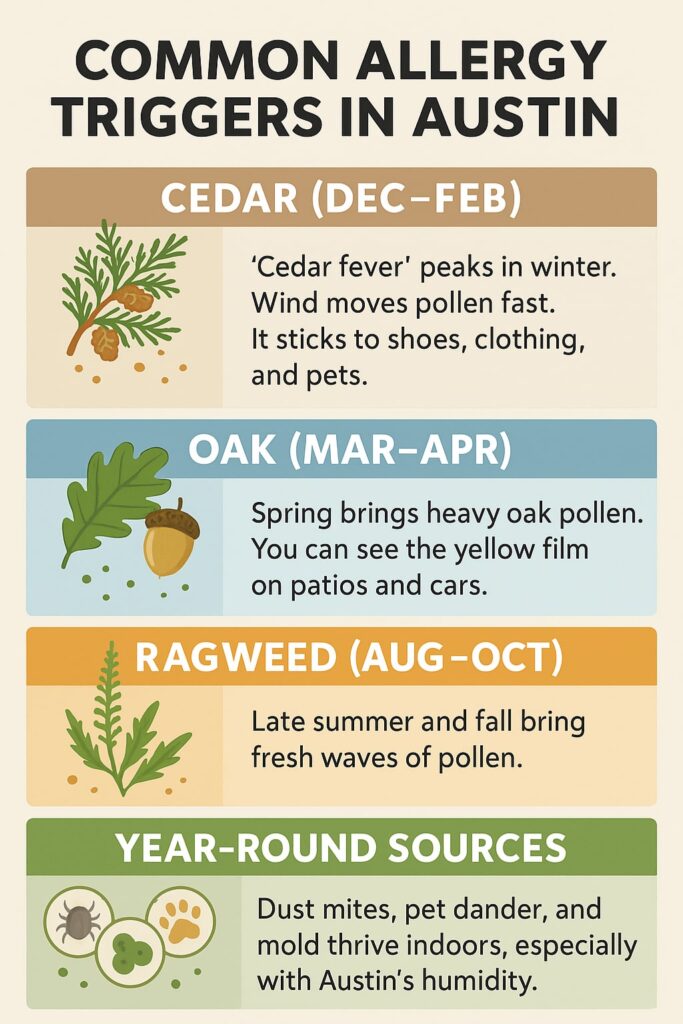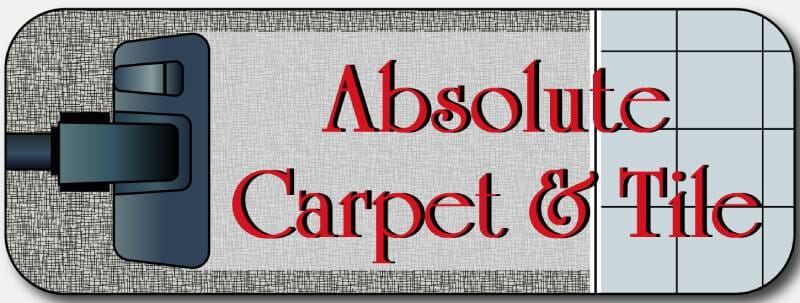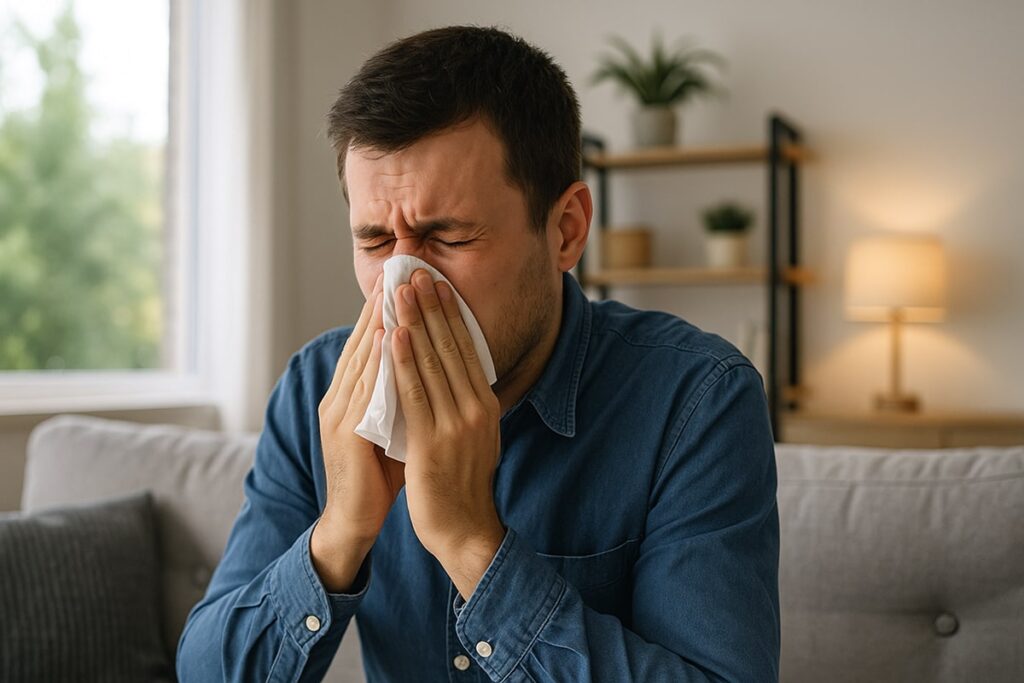Allergy season in Austin hits hard. Your eyes itch. Your nose runs. You wake up stuffy and tired. The issue may start outside, but it follows you indoors. Pollen, dust, and pet dander settle into carpet and cycle through ducts. The good news is clear: smart cleaning lowers the load and helps you breathe easier.
As a local company serving Austin since 2009, our team at Absolute Carpet & Tile sees this every year. We clean homes across Elgin, Pflugerville, Round Rock, and South Austin. We see the same pattern: after a deep clean, families report fewer symptoms and better sleep. Below, we explain why that happens and how to set a simple plan that works for Austin homes.
Austin’s Allergy Triggers: What You Track Inside
The big four in Central Texas
- Cedar (Dec–Feb): “Cedar fever” peaks in winter. Wind moves pollen fast. It sticks to shoes, clothing, and pets.
- Oak (Mar–Apr): Spring brings heavy oak pollen. You can see the yellow film on patios and cars.
- Ragweed (Aug–Oct): Late summer and fall bring fresh waves of pollen.
- Year-round sources: Dust mites, pet dander, and mold thrive indoors, especially with Austin’s humidity.
How the climate makes it worse
- Mild winters keep allergens active.
- Humid summers increase mold and dust mite activity.
- Open windows on “nice days” pull in outdoor pollen that carpets then hold.

Why Carpets Are a Problem During Allergy Season
Carpets act like giant filters
Carpet fibers trap pollen, dander, dust, and dust mite waste. That sounds helpful, but there is a catch. Every step sends tiny particles back into the air. Standard vacuums can miss what sits deep in the pile. Over time, buildup grows and symptoms rise.
Moisture invites mold
Spills, pet accidents, and tracked-in rain raise moisture. Austin’s humidity slows drying. Damp carpet and pad allow mold and mildew to form. Spores spread and trigger coughing and wheezing.
Signs your carpet is feeding your symptoms
- You feel worse in carpeted rooms and better when you leave the house.
- Symptoms spike right after vacuuming.
- Musty odors linger even after basic cleaning.
- You see dark lines along baseboards (filtration soiling).
Health Effects You Can Feel
Allergens in carpet can lead to:
- Sneezing, runny nose, and itchy eyes.
- Nighttime congestion and poor sleep.
- More asthma flare-ups.
- More use of over-the-counter meds.
Children, older adults, and pets often feel these effects first. Reducing indoor allergens improves daily comfort for the whole household.
How Professional Carpet Cleaning Helps
Hot water extraction (our go-to method)
We use hot water extraction because it gets deep into the pile. Heated solution loosens soil and allergen proteins. A powerful vacuum then removes the water and debris in one pass. This method:
- Removes microscopic particles your vacuum leaves behind.
- Neutralizes dust mites and denatures allergen waste with heat.
- Prevents mold growth by extracting moisture and speeding dry times.
- Improves indoor air quality by lowering the particle load.
Why pro equipment matters
Truck-mounted systems deliver steady heat, balanced pressure, and strong suction. Rental machines often leave carpets wet and can drive soil deeper. Our process manages moisture and airflow so carpets dry faster—usually the same day.
What we see in Austin homes
After a full hot water extraction, clients report fewer morning symptoms within days. Homes with pets notice a clear drop in dander odors. Families with infants or allergy-prone kids often schedule cleanings before cedar and again after oak season to stay ahead of the cycle.
Don’t Forget Your Air Ducts
Carpet holds allergens. Ducts spread them. Dust, pollen, and pet dander collect in returns and supply lines. Each heating or cooling cycle can push particles into rooms.
Benefits of air duct cleaning
- Removes built-up dust and allergen nests.
- Reduces recirculation of pollen during peak months.
- Helps HVAC filters work better and last longer.
Simple HVAC habits that help
- Use MERV 11–13 filters if your system allows it.
- Change filters every 60–90 days (every 30 days during peaks or with pets).
- Keep supply registers open and unblocked to improve airflow and filtration.
Seasonal Cleaning Schedule for Austin Homes
Use this simple calendar to plan ahead for local pollen waves and humidity.
Winter (Dec–Feb): Cedar season
- Service: Carpet cleaning in early December or January.
- Goal: Remove tracked-in cedar pollen, freshen bedrooms and living areas.
- Extras: Clean entry mats; wash pet bedding hot.
Spring (Mar–Apr): Oak season
- Service: Carpet cleaning + air duct cleaning after peak.
- Goal: Clear heavy oak pollen and dust that settled in ducts.
- Extras: Wipe baseboards and returns; replace HVAC filters.
Summer (May–Aug): Heat and humidity
- Service: Spot cleaning and dehumidification; schedule a mid-summer deep clean if you have pets or kids at home.
- Goal: Control moisture to limit mold and dust mite activity.
- Extras: Run a dehumidifier to keep indoor RH under 50%.
Fall (Sep–Nov): Ragweed and back-to-school dust
- Service: Air duct cleaning if you skipped spring; carpet cleaning for high-traffic zones.
- Goal: Cut ragweed residue and school-day tracking.
- Extras: Refresh area rugs and stairs; rotate furniture to reduce wear patterns.
How Often Should You Clean?
Carpet
- Vacuum: 1–2 times per week with a HEPA vacuum; daily in homes with pets or toddlers.
- Deep clean: Every 6–12 months for most homes; every 3–6 months for allergy sufferers, pet owners, or homes near heavy tree cover.
Air Ducts
- Inspection: Every 2 years.
- Cleaning: Every 3–5 years, or sooner after renovation, smoke events, or severe allergy symptoms.
Practical Tips to Cut Allergens Between Visits
- Use a HEPA vacuum. Make slow, overlapping passes in two directions.
- Add entry mats. Place mats at exterior doors and a shoe tray inside.
- Wash textiles hot. Clean bedding, throws, and washable rugs weekly during peaks.
- Manage humidity. Keep indoor RH under 50% with A/C or dehumidifiers.
- Treat spills fast. Blot, do not rub. Call for help after water leaks or pet accidents.
- Choose low-pile carpet. It traps fewer particles and is easier to clean.
Common Questions We Hear in Austin
Will vacuuming alone fix my allergies?
Vacuuming helps, but it only removes surface soil. Deep cleaning extracts particles from the base of the pile and cuts the total load.
Can you clean during cedar season or should I wait?
Clean during cedar season if symptoms are high. Removing tracked-in pollen and dander gives faster relief.
How long will carpets take to dry?
Most carpets dry the same day. We use strong extraction and air movers to accelerate drying.
I have pets. Is cleaning still safe and effective?
Yes. We use pet-safe solutions and focus on urine salts, dander, and odors. Many pet homes book three cleanings per year to stay ahead.
Why Austin Homeowners Choose Absolute Carpet & Tile
- Local roots: Owner Jeremy Adams grew up in Elgin and has served Austin since 2009.
- Clear values: Honesty, integrity, and loyalty guide our work.
- Skilled team: BBB affiliate; certified in residential and commercial carpet cleaning, tile and grout cleaning, upholstery, and water mitigation.
- No stress: Fully bonded and insured. No contracts. No hidden fees. Same-day booking confirmation.
- Consistent care: The same trusted cleaners serve your home.
We have cleaned thousands of rooms during cedar, oak, and ragweed peaks. We have seen how a focused plan changes daily life for allergy-prone families. Our goal is simple: clean fibers, cleaner air, better days.
Ready to Breathe Easier?
Allergy season will come every year. You can still enjoy your home. A smart schedule for carpet and air duct cleaning cuts allergens, lowers odors, and helps your family sleep better.
Get a free quote today. Book carpet cleaning, tile cleaning, upholstery cleaning, or air duct cleaning with Absolute Carpet & Tile. We’ll assess your space, set a clear price, and get your home back to feeling fresh and comfortable.


